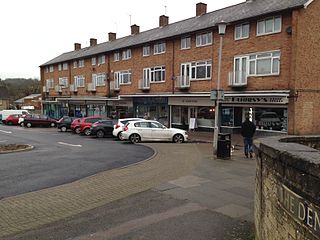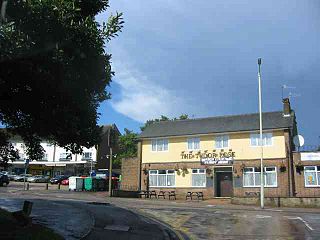
Berkhamsted is a historic market town in Hertfordshire, England, in the Bulbourne valley, 26 miles (42 km) northwest of London. The town is a civil parish with a town council within the borough of Dacorum which is based in the neighbouring large new town of Hemel Hempstead. Berkhamsted and the adjoining village of Northchurch are together encircled by countryside, much of it in the Chiltern Hills, an Area of Outstanding Natural Beauty (AONB).

Hemel Hempstead is a large town in the Dacorum borough of Hertfordshire, England. Hemel Hempstead is located 24 miles (39 km) northwest of London, and part of the Greater London Urban Area. The population, according to the 2011 Census, was 97,500.

The Borough of Dacorum is a local government district in Hertfordshire, England that includes the towns of Hemel Hempstead, Berkhamsted, Tring and Kings Langley. The district, which was formed in 1974, had a population of 137,799 in 2001. Its name was taken from the old hundred of Dacorum which covered approximately the same area. It is the westernmost of Hertfordshire's districts, being bordered to the west by the Chiltern and Aylesbury Vale districts of Buckinghamshire.

Nash Mills is a civil parish within Hemel Hempstead and Dacorum Borough Council on the northern side of the Grand Union Canal, formerly the River Gade, and in the southernmost corner of Hemel Hempstead. There is evidence of a mill in this location since the 11th century and the row of 16th century mill cottages still remain. John Dickinson established a number of papermaking mills in the area in the 19th century.

Hemel Hempstead is a constituency represented in the House of Commons of the Parliament of the United Kingdom. It elects one Member of Parliament (MP) by the first-past-the-post system of election.

Boxmoor is part of Hemel Hempstead in Hertfordshire. It is within the district of Dacorum and comprises mainly 19th-century housing and meadowland, with transport links from London to the Midlands. At the 2011 Census, the population of Boxmoor was included in the Dacorum ward of Bovingdon, Flaunden and Chipperfield.

Hemel Hempstead Rural District was a rural district in Hertfordshire, England from 1894 to 1974.

The Hemel Hempstead Gazette & Express is a local newspaper in the United Kingdom that covers the towns of Hemel Hempstead, Berkhamsted and Tring and the surrounding area in Hertfordshire.

Bennetts End is a neighbourhood within Hemel Hempstead in Hertfordshire, England. It is located in the southeast of the town and consists almost entirely of public housing built as part of the new town in the 1950s. It was the second neighbourhood to have construction commenced by the New Town corporation, after the nearby Adeyfield.

Dacorum Borough Council is the local authority for the Dacorum non-metropolitan district of England, the United Kingdom. Dacorum is located in the north-west of Hertfordshire, in the East of England region. The Council itself is based in Hemel Hempstead, the largest settlement in the district.

Chaulden is a residential district in Hemel Hempstead, Hertfordshire, England located west of the town centre and bordering on open countryside. It was an early development in the construction of Hemel Hempstead new town, commenced in 1953 and has its own neighbourhood shopping centre.
Highfield is a neighbourhood district in Hemel Hempstead, Hertfordshire, United Kingdom. It was constructed on a green field site as part of the construction of the postwar newtown expansion of Hemel Hempstead. It is located north of the old town centre. It is most likely named from Highfield House which still exists, although ultimately derived from an old field name which reflects the altitude of the district which reaches 469 feet above sea level. At the 2011 census the population of the district was included in the civil parish of Hazlemere

Peter Anthony Paul Melvin, RIBA, was an English architect. His work over a period of fifty years evolved from large-scale Brutalist projects to small-scale made-to-measure designs. He was a vice-president for education at the Royal Institute of British Architects.

130–136 Piccotts End is a medieval timber framed building in Piccotts End in Hertfordshire, England. Originally a hall house, the structure has been divided into a row of cottages. Two of the cottages are of interest for the art they contain. Important 15th century murals were discovered, at 132, in 1953 and the entire building was listed Grade I the following year. Later murals have been recorded at 134.

The Bury is a building of historical significance in Hemel Hempstead in the county of Hertfordshire, England. It was erected in about 1790 by an attorney who worked in the town. It was the residence for the next two centuries of many notable people. It is now owned by the Dacorum Borough Council and is Grade II* listed.

Dacorum Heritage (DH) is a local history advocacy group in the United Kingdom. It collects and records the history of the Borough of Dacorum, Hertfordshire, in the south of England, and aims to encourage the appreciation of the heritage of Dacorum.

Berkhamsted Town Hall is a municipal building in the High Street, Berkhamsted, Hertfordshire, England. It is a Grade II listed building.

Aylesbury Town Hall is a name which has been used for two different buildings in Aylesbury, Buckinghamshire, England. Since 2007 the name has been used for an office building at 5 Church Street, which serves as the headquarters of Aylesbury Town Council. The name was also formerly used for a complex of buildings which had been built in 1865 as a corn exchange in Market Square, and which served as the offices and meeting place of the local council from 1901 to 1968. The majority of the old town hall was demolished shortly afterwards, leaving only the entrance archway facing Market Square still standing, now called Town Hall Arches. This remaining part of the old town hall is a Grade II* listed building as part of the range of civic buildings on the southern side of Market Square including the old County Hall.

Tring Market House is a municipal building in the High Street, Tring, Hertfordshire, England. The structure, which is the meeting place of Tring Town Council, is a Grade II listed building.

Berkhamsted Civic Centre is a municipal building in the High Street in Berkhamsted in Hertfordshire, England. The structure accommodates the offices and meeting place of Berkhamsted Town Council.




















